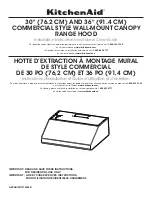
5
Cabinet Dimensions
Venting Requirements
■
Vent system must terminate to the outdoors.
■
Do not terminate the vent system in an attic or other
enclosed area.
■
Do not use a 4" (10.2 cm) laundry-type wall cap.
■
Use metal vent only. Rigid metal vent is recommended.
■
The length of vent system and number of elbows should be
kept to a minimum to provide efficient performance.
For the most efficient and quiet operation:
■
Use no more than three 90° elbows.
■
Make sure there is a minimum of 24" (61.0 cm) of straight
vent between the elbows if more than 1 elbow is used.
■
Do not install 2 elbows together.
■
Use clamps to seal all joints in the vent system.
■
The vent system must have a damper. If roof or wall cap has
a damper, do not use damper supplied with the range hood.
■
Use caulking to seal exterior wall or roof opening around the
cap.
■
The size of the vent should be uniform.
Cold Weather Installations
An additional back draft damper should be installed to minimize
backward cold air flow and a thermal break should be installed
to minimize conduction of outside temperatures as part of the
vent system. The damper should be on the cold air side of the
thermal break.
The break should be as close as possible to where the vent
system enters the heated portion of the house.
Makeup Air
Local building codes may require the use of makeup air systems
when using ventilation systems greater than specified CFM of
air movement. The specified CFM varies from locale to locale.
Consult your HVAC professional for specific requirements in your
area.
Venting Methods
This canopy hood is factory set for venting through the roof or
wall.
A 3
1
⁄
4
" x 10" (8.3 x 25.4 cm) rectangular vent system is needed
for installation (not included). The hood exhaust opening is
3
1
⁄
4
" x 10" (8.3 x 25.4 cm). Vent system can terminate either
through the roof or wall. To vent out of the top of the range hood
and through a wall, a 90° elbow is needed. See “Install Range
Hood” section for details for installing the damper.
NOTE:
Flexible vent is not recommended. Flexible vent
creates back pressure and air turbulence that gently reduce
performance.
A. For installations with
canopy only.
70" (177.8 cm) minimum
above electric cooking
surface.
76" (193.0 cm) minimum
above gas cooking surface.
B. For installations with
optional duct cover.
82" (208.3 cm) minimum
above electric cooking
surface.
88" (223.5 cm) minimum
above gas cooking surface.
Back view
(2.9 cm)
1
1
/
8
"
7" (17.8 cm): 30" (76.2 cm) models
9
7
/
8
" (25.0 cm): 36" (91.4 cm) models
Wiring knockout
(20.0 cm)
7
7
/
8
"
12
" (31.0 cm)
5/8"
(1.6 cm)
3
/
16
30" (76.2 cm) models: 12¼" (31.1 cm)
36" (91.4 cm) models: 15" (38.1 cm)
13" (33.0 cm)
18" (45.7 cm)
minimum
36" (91.4 cm)
clearance upper
cabinet to countertop
countertop height
30" (76.2 cm) or 36" (91.4 cm)
cabinet opening width
(If installed between cabinets)
A B
Minimum cabinet
opening width
X
Bottom of canopy
to cooking surface
Duct cover (if used
)
Canopy
IMPORTANT:
Minimum distance “X” : 24" (61.0 cm) to electric cooking surface
and 30" (76.2 cm) to gas cooking surface.
Suggested maximum distance “X” : 36" (91.4 cm)
Содержание KVUC606J55
Страница 26: ...26 Remarques Remarques ...
Страница 27: ...27 Remarques ...
Страница 28: ...28 Remarques ...
Страница 29: ...29 Remarques ...
Страница 30: ...30 Remarques ...
Страница 31: ...31 Remarques ...






































